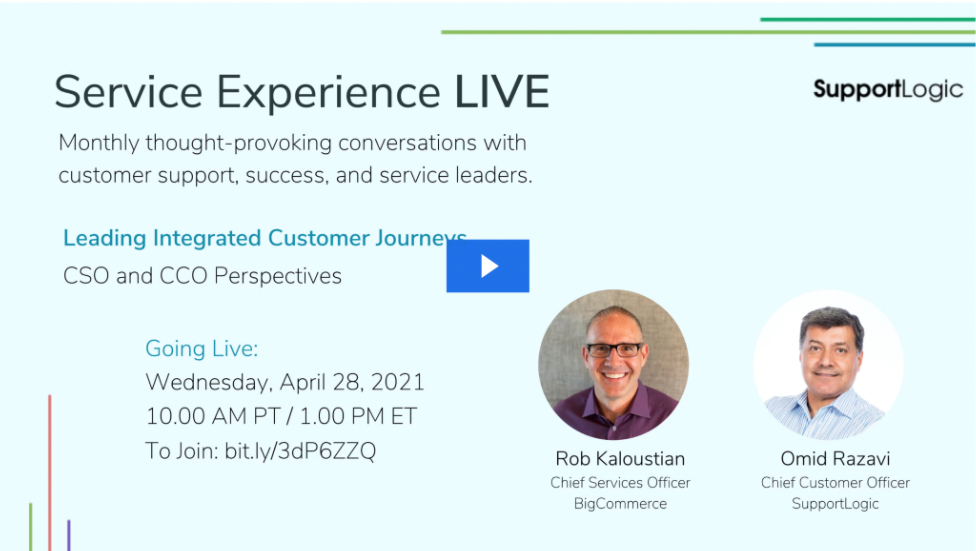
May 16, 2021
Leading Integrated Customer Journeys: CSO and CCO Perspectives
chief customer officer
Omid Razavi, Chief Customer Officer, SupportLogic, hosted Rob Kaloustian, Chief Services Officer, BigCommerce, for a conversation about what it takes to deliver stellar customer experiences. The discussion covered topics including the skills and capabilities needed to provide an integrated customer journey, how to maintain strategic alignment with customer needs, prioritizing technology decisions that deliver customer outcomes, and how to meet your CEO’s objectives and expectations regarding CX.

Here are the top 10 takeaways from SupportLogic’s Service Experience Live:
1. Mindset matters – what’s now and what’s next.
Invest time in interacting with leaders, mentors, colleagues and customers to get into the mindset of ‘what’s next’. The best way to deliver exceptional service is to put yourself in their shoes and anticipate what’s next. You need to consciously get into the habit of thinking and finding out what is missing. Constantly evaluating and answering the question: ‘How can I add value?’ is not something that can be taught via a structured training program in a classroom. It is a mindset that you develop over many interactions with all stakeholders.
2. Find the right operational cadence.
When it comes to sales and professional services functions, it is no longer ‘us vs them’. There is a lot of opportunity for cross-pollination of ideas and knowledge exchange between the two functions. By integrating the front-end and the back-end, support becomes more seamless with improved insight on what is expected to be delivered and what is missing. The right operational cadence frees up time and lets you explore new opportunities for innovation.
3. Be customer-centric and not just product-centric.
By aligning outcomes with what customers are trying to do, you can refine your offering and deliver better results. While it is good to focus on getting the product up and running, it is absolutely vital to find out what outcomes the customer expects. Understanding what they need to make their business thrive and how customers measure that becomes imperative to capture. If you see a need for repeatability, you can build an offering around it.
4. Don’t worry about the fear. Embrace the whole journey.
When it comes to enabling a great customer journey, gravitating towards only one function will not give you the full picture. Embrace different roles to try and get a better view with more insights. Follow technology and all the new tools to know the trends and don’t run away from things you fear. There’s an opportunity to have a bigger impact when you get involved in the whole customer journey.
5. Live in customer conversations. Not just cold data.
While there are multiple tools to crawl through customer data, relying only on cold data means looking at only a part of the picture. Harnessing and analyzing customer conversations provides valuable insights on what’s working and what can be improved. There may be tons of data sets that you’ve previously collected but nothing matches the weight of voices from hundreds or thousands of customers who use your product today.
6. Listen with intent to understand. Not to change.
Many seasoned leaders and decision-makers approach conversations with a pre-set agenda. It is important to build relationships first and immerse yourself into how things work and what the objectives are. When taking up a new role, it is important to set aside learning from a prior experience and not try to force-fit solutions just because they worked in a previous setting.
7. Support is a team sport.
Over time, there has been an evolution in the way tickets are resolved with many new models coming into the picture. Tiering, swarming and hybrid support models to name a few. A tier model is good as long as the first tier solves about 80% of the problem instead of just collecting data. A swarm model works great because different people pitch in instead of relying only on one support engineer.
8. Focus on customer sentiment to improve overall account growth.
It goes without saying that maintaining good ticket hygiene is essential. But, if you are myopically focused only on fixing a customer’s problem, you may not be paying attention to the overall emotion that the customer is expressing. Customer sentiment insights are important for account teams to find expansion opportunities and plan future account engagement strategies.
9. Assess your strengths and biases.
Talk to experts, rope in consultants, engage with the process owners, the frontline people and the customers to map the entire customer journey. Put in a framework and get that into your muscle memory by bringing in the ‘athletes’ (consultants) and train with them so that it becomes a part of your DNA. Sometimes, this ‘outside-in’ approach works wonders because of the new perspectives that are brought in.
10. It’s never too late.
It’s only late if you never do it. You don’t have to run a marathon. Just walk. Start with baby steps if you don’t already have a defined and integrated customer success and support function. Let’s say you want to get your renewal rates up by 5%. Talk with all stakeholders and get them on board with conducting an experiment. Become laser-focused on that particular goal and once you get everyone involved, it becomes a worthwhile effort and a step in the right direction.
What is your take on Omid and Rob’s conversation on Leading Integrated Customer Journeys – CSO and CCO Perspectives? You can reach out to them directly at omid@supportlogic.io and rob.kaloustian@bigcommerce.com.
If you didn’t get a chance to attend the live event, you can watch it here.
Make sure to tune in to the next session of Service Experience LIVE, a series of monthly thought-provoking conversations with customer support, success and service leaders.
Don’t miss out
Want the latest B2B Support, AI and ML blogs delivered straight to your inbox?





